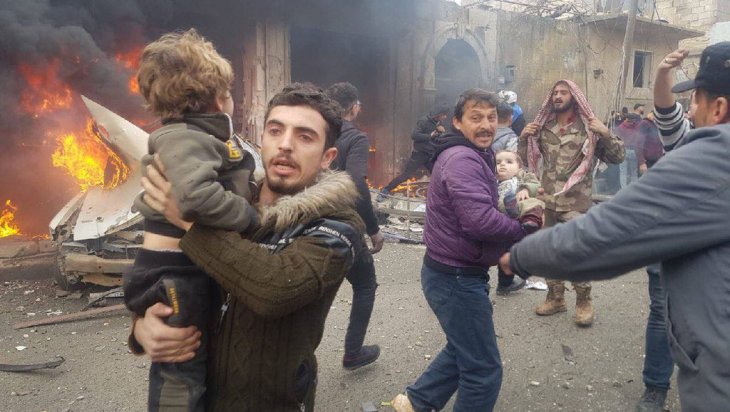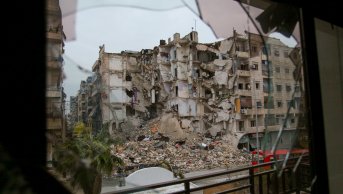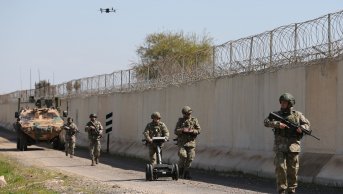Analysis of the Increasing YPG Attacks on the Safe Zones in Syria

The regions in northern Syria that were cleansed of terror by the operations Euphrates Shield, Olive Branch and Peace Spring led by the Turkish Armed Forces (TSK) together with the Syrian National Army (SNA) components are now targeted by the YPG/PKK, ISIS and forces loyal to the regime. Among these attacks, the terrorist acts of the YPG stand out in terms of numbers. The YPG’s strategic priority is to control Syria’s northern borders to ensure geographical integrity. In doing so, the YPG wants to make the TSK-controlled safe zones uninhabitable for the civilian population, present the Turkish model as a failure in front of other regions in Syria and the international public, and force Turkey and the SNA to withdraw from the region through intimidation campaigns. This study includes the statistics of attacks perpetrated on the Turkey-controlled safe zones in January-February 2021. These figures clearly show the extent of the YPG’s attacks on the safe zones.
In what areas have the attacks been most concentrated?
The Peace Spring region stands out as the region that was exposed to the most attacks/attempted attacks in January 2021. According to the January 2021 data, 3 car bombings and 11 infiltration attempts were carried out by the YPG in the Peace Spring region, which includes the settlements of Tal Abyad and Ras al-Ayn. The attack in Ras al-Ayn on 2 January and the attacks in Tal Abyad on 26 January were carried out using the same method. These attacks, which were carried out by detonating bomb vehicles in urban centres with dense civilian populations, show that the YPG is trying to spread fear among inhabitants of the region through sensational actions directly targeting civilians. The attack in Tal Abyad on 6 January was perpetrated after an infiltration attempt when an explosive placed on the road was detonated during the passage of civilians. The Euphrates Shield region was the second most attacked region in January 2021. There were 4 terrorist attacks, and 7 infiltration attempts in the region. The YPG attacked the Sicco village in Azez on 17 January and Jarabulus on 27 January. The simultaneous attacks on Azez and al-Bab on 31 January were recorded as the YPG’s bloodiest terrorist attacks in January 2021. Attacks on the Euphrates Shield region continued to increase in February. The YPG carried out two attacks on the Afrin-based Olive Branch region in January 2021. Many civilians were killed or wounded in the second attack on the industrial area in the city centre on 30 January.
Not only is the number of attacks on these areas noteworthy, so are the targets of the attacks. The attacks target civilians, including children. A total of 24 civilians, including 4 children, were killed and 69 civilians injured in the attacks on the safe zones in January 2021. These numbers increased further with the attacks in February 2021. The attacks were mainly directed against crowded places, such as bazaars, with the intention of making an impact. It was also observed that the YPG detonated some bombs as a provocation during the distribution of aids by the TSK, which did not result in deaths or injuries.
Attacks emanating from Manbij and Tal Rifat tend to increase.
Manbij and Tal Rifat have been used as the main attack bases in the YPG’s actions. On 6 February, an attack was carried out from Tel Rifat on olive farmers in Azez and, on 15 February, mortar attacks were carried out from Manbij on the south of Jarabulus and the villages of Um Adasah and al-Sukariyyad in al-Bab. Due to this security threat, Turkey has been demanding the removal of the YPG from these regions, previously from the United States and currently against Russia.
While the YPG has tended to use vehicle bombs and IED devices in the attacks on the safe zones, it has brought alternative methods into play in the attacks on Manbij and Tal Rifat due to the fact that these cities are intertwined with the safe zones. Mortar and rocket attacks are the leading methods of attack. These areas also enable infiltration attempts by the YPG. In addition to infiltration attempts via land, the YPG infiltrated the Amanos Mountains with a paramotor from Manbij in October 2020. The YPG’s presence in Manbij and Tal Rifat, therefore, poses a security risk not only to the safe zones in Syria, but also directly to Turkey’s territory. In other words, unless Manbij and Tal Rifat are completely cleared of the YPG, it will not be possible to fully guarantee the security of the safe zones in Syria and the border areas of Turkey.
Timing of the increase in attacks
The YPG has targeted the Turkey-controlled safe zones since the day they were established. The latest attacks can therefore be a continuation of this act. We can observe that the number and lethality of attacks have increased since the beginning of January 2021. There could be several explanations for this from a temporal point of view. The first explanation is the victory of Biden in the US presidential election. The YPG expects this result to strengthen its position in Syria. The fact that Biden’s team would include names with close ties to the YPG, namely Brett McGurk, may have encouraged the organization. The YPG estimates that the crisis in Turkish-American relations would also deepen under Biden. The YPG may be seeking to force Turkey into a confrontation with the US. Another possibility could be the fact that Turkey has increased the pressure on the organization in areas such as northern Iraq and Ayn Issa. The PKK may want to respond to Turkey’s growing pressure through the YPG. A noteworthy final point as an explanation for timing of the increased terrorist actions could be the call of Ferhat Abdi Sahin, a YPG leader, in a recent interview emphasising: “fight against the PKK, dialogue with Turkey and Syrianism”. This reveals the PKK’s control over the YPG, regardless of the intention of Ferhat Abdi Sahin’s rhetoric.
How does the TSK respond to these increasing attacks?
The TSK primarily responds to the YPG’s actions with coercive measures. Attempts by the YPG to penetrate the safe zones in January 2021 were met with a harsh response by the TSK, and a total of 71 YPG/PKK members were neutralised. Most of the retaliatory attacks by the TSK took place around the Peace Spring region east of the Euphrates. In addition to deterrent measures, the TSK also organizes activities to raise awareness among people in the region and in particular children against acts of terrorism. The TSK regularly visits schools in the safe zones and the children are informed about many matters such as IED and mines. Meanwhile, the TSK continues to train SNA-affiliated military units in preventing infiltration attempts and combating traps.
What awaits the safe zones?
A short-term end to the YPG’s destabilising activities in the safe zones is not to be expected. The fact that those who have a say in US foreign policy under Joe Biden consider the YPG to be their closest ally in Syria could encourage this organization to carry out more attacks on the safe zones. An increase in such attacks could increase Turkey’s new military operations in northern Syria in the medium term. Taking into account that the YPG/PKK has recently also been planning actions in Turkey in addition to the safe zones, it can be said that Turkey’s resort to coercive measures is a serious possibility. According to the agreement made with Russia after Operation Peace Spring, the border line must be completely cleared of the YPG. This agreement will also provide a legitimate basis for Turkey’s new moves.









